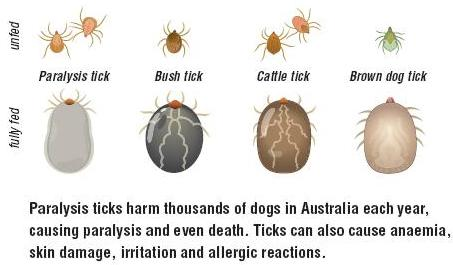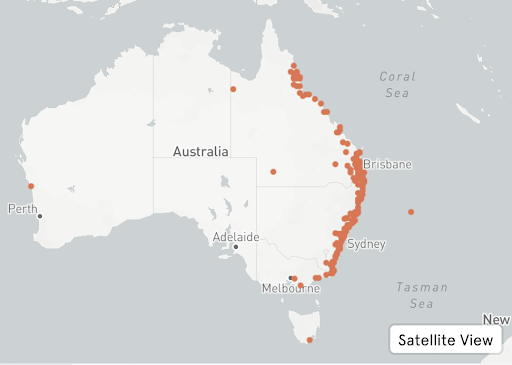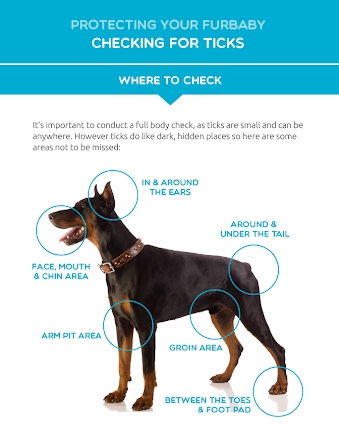Signs and Symptoms of Tick Paralysis in Pets
What is a tick?
Ticks are blood sucking parasites – often confused with fleas as they both feed on blood. Ticks are closely related to spiders, you can tell from their 8 legs. There are several species of ticks found in Sydney: bush ticks, brown ticks and paralysis ticks (Figure 1).

Figure 1: Tick species in Australia (Virbac Australia)
All ticks can carry blood-borne parasites which causes lethargy, inappetence and pale gums. However, a bite from a paralysis tick carries the highest risk. Generally, a tick has to be more than 4mm large and attach for 4 days or more to cause clinical signs. However, this can vary dramatically depending on the potency of the tick’s neurotoxins, the season of the year and the susceptibility of your furbaby to the toxin.
After attaching to your furbaby, a paralysis tick injects its saliva into the bloodstream while feeding on the blood. Its saliva contains a neurotoxin, which affects every muscle in the body, slowly weakening and paralysing them. Muscles in the limbs are usually the first to be affected – that’s why the first clinical signs are often wobbly gait and loss of balance. The muscles supporting breathing and swallowing can also be affected, leading to more serious conditions that can be life-threatening.
What are the clinical signs of tick paralysis?
- Change in gait/ incoordination
- Change in bark or meow
- Vomiting or retching or difficulty swallowing
- Heavy breathing (grunting and panting)
- Heavy salivation
- Weakness
- Collapse

Figure 2: Distribution of paralysis tick in Australia (https://sashvets.com/pet-advice/tick-paralysis/).
Where and when can paralysis ticks be found?
Paralysis ticks are mainly found in the humid, coastal areas of Eastern Australia from North Queensland to Eastern Victoria (Figure 2).
Paralysis ticks can be found all year round, especially between Spring to Autumn. Occasionally, paralysis tick cases have also been reported in Winter.
How do I prevent tick paralysis?
There are different types of tick preventions on the market: spot-ons, tablets and collars. Regardless of what you choose, please use the product as directed. It’s really important to read the directions to fine prints.
If you use a spot on, please be careful not to let your furbaby get wet. For a collar, make sure you’re replacing them frequently and for tablets, make sure to get the correct dose for the recommended weight.
Most importantly, NEVER use a dog product on cats. The only product available for cats registered in Australia is the Frontline Plus Spot on, which has to be applied every fortnightly. Many products such as Advantic, while safe for dogs, are toxic to cats.
How to check for ticks on your furbaby:
Start by running your fingers through the coat of your furbaby all the way down to their skin. Do this systemically through their entire body. Ticks usually jump onto a dog or cat then attach by burying their mouthpiece into the skin. Ticks can attach anywhere but prefers the front half of the body (Figure 3).

Figure 3: Areas to check for ticks on your furbaby
How do I remove them?
The most reliable way to remove a tick is to do so manually. Grasp the tick as close to the point of attachment (the tick’s head) as possible and pull up with steady pressure. Attempt to do this without squeezing the tick’s body. You can do this with a pair of tweezers or a specialised tick remover. Try not to twist or jerk as you pull them away – as their mouthpiece can rip out and be left behind in the furbaby’s skin.
After removing a tick, it is always a good idea to bring your furbaby and the tick with you for identification. Closely monitor your furbaby for any clinical signs of tick paralysis even if they first appear to be well. If clinical signs appear, we recommend you to present your furbaby to a veterinary clinic or an emergency hospital immediately as the animal may deteriorate quickly. Do not offer food or water especially if your furbaby is showing signs of difficulty in breathing or swallowing. In some cases, an emergency hospital with a ventilator and critical care facilities may be required.


